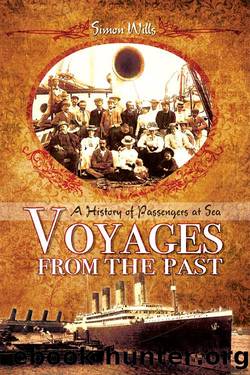Voyages from the Past: A History of Passengers at Sea by Wills Simon

Author:Wills, Simon
Language: eng
Format: epub
Publisher: Pen and Sword
Published: 2014-10-30T00:00:00+00:00
Chapter Ten
A Tragic Storm in the Bay of Biscay
(1866, John Munro, SS London)
John Munro was a Scot, who at the age of around 30 settled in Ballarat, Australia, as a gold miner. However, he had good knowledge of ships because he had been a sailmaker and rigger, and went to sea in this capacity for five-and-a-half years before emigrating. He had been shipwrecked before as a young man, and been trapped in Central America for months trying to secure a passage home. In 1865, aged 36, he came home to Scotland to visit his family, and as the year came to a close, he sought to return to Australia.
The ship that Munro chose in late December 1865 was the SS London. She was virtually a new ship, having been launched in 1864, and was owned by Money Wigram and Sons, a company with a perfect safety record, having lost no passenger ships since the companyâs first voyages in 1847. The London, which was around 270 feet long with an iron hull and three masts, was in a different class to many contemporary vessels, being fitted out in luxury to improve the passenger experience on long voyages.
All passenger ships at this time transported significant amounts of cargo: ship owners packed as much on board as they could to increase the profits from a voyage, and such vessels were frequently accused of being âoverladenâ. For example, the Londonâs cargo was valued at more than £125,000, whereas the ship itself was only worth £80,000, and the passengersâ fares generated perhaps £4,000 at most. The Londonâs large load in 1865 included dead weight such as iron and stone blocks, hardware and tools, and light goods such as textiles, china and medicines. The London also carried 500 tons of coal for fuel; the bulky commercial cargo meant that several tons of coal had to be stored on the main deck in sacks.
Built for the run to Australia, the London was a fast ship, having made its previous outward voyage in just 59 days, while a sailing ship commonly took three-and-a-half months. The vessel was driven by a single propeller and had a top speed of about nine knots.
The ship had a crew of around 80, including seamen, officers, engine room personnel, canteen staff and stewards. A relative novelty at the time, there was also a female crew member: Grace Logan was a stewardess who tended to the needs of female passengers and children.
The Londonâs captain was John Bohun Martin, an experienced mariner, and known to be very attentive to his passengers. Exact numbers differ between sources, but there were about 160 passengers on board â around 60 in first class, 50 in second class and 50 in third class. John Munro travelled second class, which meant he shared his sleeping area with other passengers rather than having his own cabin, and he also received a more restricted menu at mealtimes.
As has become well known because of later disasters such as the Titanic, ships were not required to carry enough lifeboats to rescue everyone on board.
Download
This site does not store any files on its server. We only index and link to content provided by other sites. Please contact the content providers to delete copyright contents if any and email us, we'll remove relevant links or contents immediately.
| Automotive | Engineering |
| Transportation |
Urban Outlaw by Magnus Walker(2950)
Never by Ken Follett(2884)
OPNsense Beginner to Professional by Julio Cesar Bueno de Camargo(2806)
Sapiens and Homo Deus by Yuval Noah Harari(2416)
Machine Learning at Scale with H2O by Gregory Keys | David Whiting(2293)
A Short History of Nearly Everything by Bryson Bill(2135)
Will by Will Smith(2043)
Hooked: A Dark, Contemporary Romance (Never After Series) by Emily McIntire(1965)
Borders by unknow(1786)
Rationality by Steven Pinker(1765)
Holy Bible (NIV) by Zondervan(1716)
Freedom by Sonny Barger(1485)
The One Percenter Encyclopedia by Bill Hayes(1463)
Five Ways to Fall by K.A. Tucker(1397)
Girls Auto Clinic Glove Box Guide by Patrice Banks(1363)
Far and Near by Neil Peart(1357)
The Becoming by Nora Roberts(1331)
Cuba's Car Culture by Tom Cotter(1325)
A Short History of War by Jeremy Black(1300)
